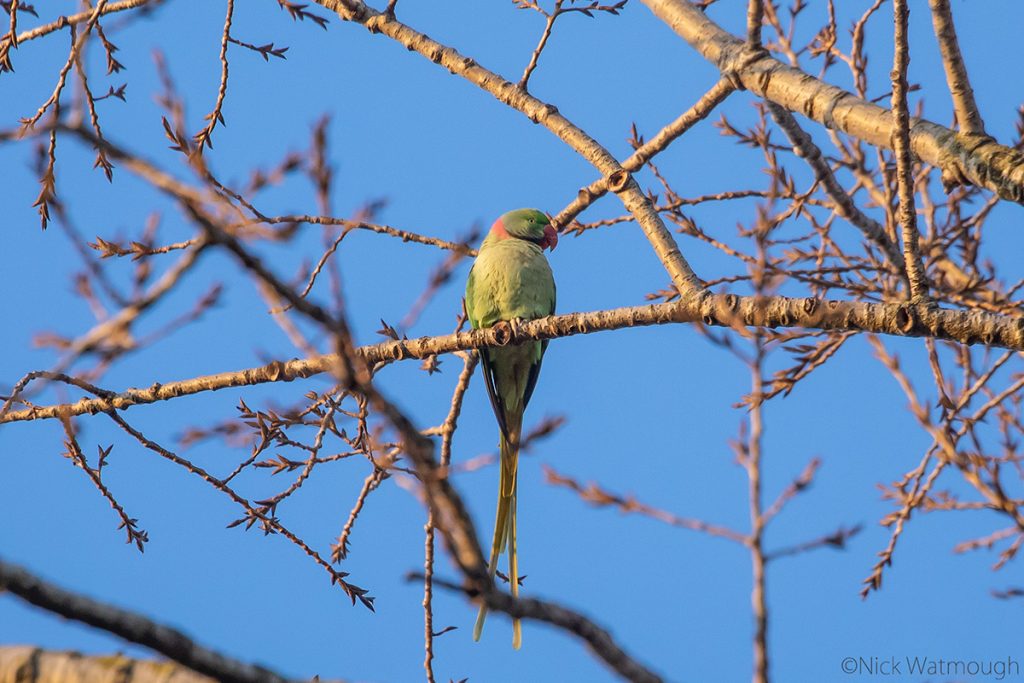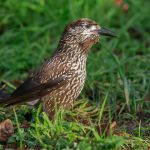Work took me to Amsterdam for a couple of days in late January and it did not take to convince me to stay an extra day to try and photograph a Nutcracker that had taken up residence in a Wageningen suburb. Setting off in the dark under cold clear skies I travelled by East by train across a flat hoar frosted landscape past fields full of grey geese. Arriving in Ede I transferred to a local bus service and half an hour later I disembarked at Wageningen bus station.

Guided by Google Maps I took a short walk past a parade of shops and at the first junction I looked up to cross the road and did a double take . There was the Nutcracker! In the driveway opposite exploring a large bag of peanuts closely monitored by the donors – a small group of birders on a day trip from the UK.

The bird is of the Siberian “Slender-billed” form (subspecies macrorhyncus) which is prone to vagrancy and even periodic irruptions (for example in 1968), rather than a bird of the nominate race from the Alps. Being from so far East and with no prior experience of humans it is totally fearless seeing it’s admirers only as a benign source of free food and artificial perches. Such behaviour is not unprecedented as anybody, like me, who made the journey to Cocknage Wood in Staffordshire in the autumn of 1991 to see the last twitchable individual in the UK will testify. Being so trusting of humans could have been the downfall of the Wageningen bird which abandoned the area in which it was originally found (1-2 km away) due to New Year’s Eve fireworks, before being rediscovered a couple of days later in its current network of gardens.
Wherever it came from it is an entrancing bird to watch. I enjoyed spending time in its company observing the dexterous way it employed feet and bill to break open nuts and extract the nutritious kernel. More often than not was buried for future consumption as insurance against leaner times.

Nutcracker Gallery – click on the thumbnail to view a larger image
After spending a couple of hours with this most engaging and charismatic of crows I retraced my steps and returned to Amsterdam Central Station. From there I made my a way to the Vondelpark in Amsterdam Zuid which has a reputation for being a reliable for site for a naturalised and self-sustaining population of Alexandrine Parakeets.

As might be expected of a city centre park on a Saturday afternoon it was very busy; full of families, cyclists and joggers enjoying the winter sun. Like some of the London parks Vondelpark is built around a series of artificial ponds that hold a range of very approachable water birds; Cormorant, Moorhen, Coot, Egyptian Goose and a few duck.

Finding parakeets in the park is not exactly difficult. Not only are they noisy and obvious, but the population of the commoner Ring-necked Parakeet in Amsterdam is enormous. And unfortunately for the first 40 minutes or so every bird that I looked at was exactly that – RNP!

Fearing failure I took some time out to listen to the calming sounds of a lakeside Handpan player. This is a percussion instrument that I had not come across previously, but one which seemed totally in keeping with the chilled atmosphere of this city centre oasis in the tranquility of the late afternoon sun.
Turning around from the Handpan player I noticed two parakeets higher in the trees than most of the birds I had seen thus far. Craning my neck to view through binoculars I could see the extensive pink rear nape and shoulder patch that characterise Alexandrine Parakeet (WP#702).

By now the light was starting to go and more than happy with how the day had worked out I headed back to my hotel in Amstelveen for a hot shower and early dinner mindful of my 6am start the following morning to make my flight back to Norwich.



















